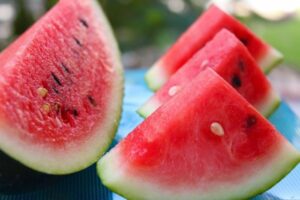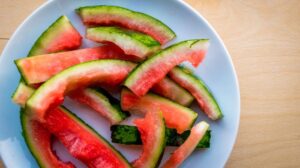When to harvest watermelon – Harvesting watermelon at the peak of ripeness is crucial for enjoying its sweet and juicy flesh. In this comprehensive guide, we delve into the telltale signs of watermelon ripeness, explore the variations in harvest time based on variety and region, and provide expert tips for proper harvesting and post-harvest handling.
Signs of Watermelon Ripeness

Determining the ripeness of a watermelon is crucial for savoring its sweet and juicy flesh. Several telltale signs indicate that a watermelon has reached its peak maturity and is ready for harvest.
Color Changes
As a watermelon ripens, its rind undergoes a gradual transformation. The initially bright green surface gradually turns dull and develops a creamy yellow or ivory hue on the side that rests on the ground. This color change is a reliable indicator of the watermelon’s increasing sugar content.
Development of Tendrils
The tendrils, which are small, wiry structures on the watermelon’s vine, also provide valuable clues about its ripeness. When the watermelon is immature, the tendrils are green and flexible. However, as it ripens, the tendrils turn brown and become brittle, indicating that the fruit is nearing its prime.
Hollow Sound
Tapping the watermelon with your knuckles can reveal its ripeness. An unripe watermelon will produce a solid, thud-like sound, while a ripe watermelon will resonate with a hollow, dull thud. This difference in sound is due to the increased sugar content and reduced water content in a ripe watermelon, which creates air pockets within the fruit.
Determining Harvest Time by Variety
Different watermelon varieties have different ripening times, making it crucial to know the specific characteristics of each variety to determine the optimal harvest time.
The following table provides an overview of popular watermelon varieties, their approximate harvest times, and additional information on seedless, heirloom, and hybrid varieties:
Watermelon Variety Harvest Time Information
| Variety | Harvest Time | Seedless | Heirloom | Hybrid |
|---|---|---|---|---|
| Sugar Baby | 70-80 days | Yes | No | Yes |
| Crimson Sweet | 80-90 days | No | Yes | Yes |
| Moon and Stars | 85-95 days | No | Yes | No |
| Jubilee | 90-100 days | Yes | No | Yes |
| Carolina Cross | 95-105 days | No | Yes | No |
| Charleston Gray | 100-110 days | No | Yes | No |
Regional Variations in Harvest Time
/when-to-harvest-watermelon-2539591-04-f7f99d3a73d846cb9d453f8a6f0cc7ee.jpg?w=700)
The timing of watermelon harvest is not only determined by variety but also by regional factors such as climate and growing conditions. These factors can influence the rate of fruit development and ripening, affecting the optimal harvest time.
In warmer regions with longer growing seasons, watermelons tend to ripen earlier than in cooler regions with shorter growing seasons. The availability of sunlight, temperature, and rainfall can all impact the ripening process. For example, high temperatures can accelerate ripening, while excessive rainfall can delay it.
Adjusting Harvest Time Based on Regional Factors
To determine the appropriate harvest time for your region, consider the following factors:
- Temperature: Watermelons thrive in warm temperatures, with ideal temperatures ranging from 70 to 90 degrees Fahrenheit (21 to 32 degrees Celsius). When temperatures are consistently above 80 degrees Fahrenheit (27 degrees Celsius), watermelons may ripen more quickly.
- Rainfall: Excessive rainfall can waterlog the soil, reducing oxygen availability to the roots and slowing down fruit development. If heavy rains are expected, it may be necessary to delay harvesting until the soil has had a chance to drain.
- Sunlight: Watermelons require plenty of sunlight to produce sugars and ripen properly. In regions with shorter daylight hours, watermelons may need additional time to mature.
By understanding the regional factors that influence watermelon ripening, you can adjust your harvest time accordingly to ensure optimal fruit quality and flavor.
Soil Conditions and Harvest
Watermelons thrive in well-drained, sandy or loamy soil with a pH between 6.0 and 6.5. Soil moisture, pH levels, and nutrient availability all play crucial roles in determining the optimal harvest time for watermelons.
When soil moisture is too high, it can hinder the development of the watermelon’s root system and increase the risk of disease. Conversely, when soil moisture is too low, the watermelon will not be able to absorb the necessary nutrients and water to reach its full potential.
Soil pH levels also affect the availability of nutrients to the watermelon plant. When the pH is too acidic or too alkaline, the plant may not be able to absorb the nutrients it needs to produce a high-quality watermelon.
Nutrient Availability
The availability of nutrients in the soil is also essential for the growth and development of watermelons. Nitrogen, phosphorus, and potassium are the three main nutrients that watermelons need in large quantities. If these nutrients are not available in sufficient amounts, the watermelon will not be able to reach its full potential.
By understanding the ideal soil conditions for watermelon growth and the impact of soil moisture, pH levels, and nutrient availability, farmers can better determine the optimal harvest time for their watermelons.
Impact of Weather Conditions
Weather conditions play a significant role in determining the harvest time of watermelons. Temperature, humidity, and rainfall all influence the ripening process.
Temperature
Watermelons thrive in warm temperatures between 70-85°F (21-29°C). Temperatures below 60°F (16°C) can slow down ripening, while temperatures above 90°F (32°C) can cause sunscald and reduce fruit quality.
Humidity
High humidity can promote disease and increase the risk of blossom-end rot. Optimal humidity levels for watermelon growth are between 50-70%. Extended periods of high humidity can also delay ripening.
Rainfall
Watermelons require adequate moisture, but excessive rainfall can lead to waterlogged soil, which can rot the roots and stunt growth. Heavy rainfall during the ripening period can also dilute the sugar content of the fruit, affecting its sweetness.
Extreme Weather Events
Extreme weather events, such as hail, storms, and heat waves, can significantly impact watermelon ripening and harvest. Hail can damage the fruit, while storms can knock down vines and reduce yields. Heat waves can accelerate ripening, but can also lead to sunburn and reduced fruit quality.
Proper Harvesting Techniques
When harvesting watermelon, it is crucial to use the correct techniques to ensure optimal quality and prevent damage. Here’s a step-by-step guide to help you harvest watermelon properly:
Using Sharp Tools
Use a sharp knife or shears to cut the watermelon from the vine. A dull tool can crush or tear the fruit, making it susceptible to rot and reducing its shelf life.
Cutting at the Right Point
Cut the watermelon at the point where the tendril (the small, curly stem attached to the fruit) meets the vine. This indicates that the watermelon has reached maturity and is ready to be harvested.
Handling the Fruit Gently
Handle the watermelon gently to avoid bruising or damaging the rind. Support the fruit with both hands when cutting or carrying it. Rough handling can lead to cracks or cuts, compromising the watermelon’s quality.
Post-Harvest Handling
Proper post-harvest handling is crucial to maintain watermelon quality, extending its shelf life and preserving its nutritional value.
Optimizing storage conditions, temperature control, and transportation methods are key factors in post-harvest handling.
Storage Conditions
- Store watermelons in a cool, well-ventilated area with a temperature between 50-55°F (10-13°C) and relative humidity of 85-90%.
- Avoid storing watermelons near ethylene-producing fruits or vegetables, such as bananas or apples, as this can accelerate ripening.
Temperature Control
- Maintain a constant temperature during storage and transportation to prevent chilling injury or over-ripening.
- Monitor temperature using thermometers and adjust cooling or heating systems as needed.
Transportation Methods, When to harvest watermelon
- Transport watermelons in refrigerated trucks or containers to maintain optimal temperature.
- Use padded or cushioned materials to prevent bruising or damage during transportation.
Wrap-Up

Mastering the art of harvesting watermelon empowers you to savor the delectable taste and nutritional benefits of this summer favorite. Remember, patience and observation are key to reaping the rewards of a perfectly ripe watermelon.
Questions Often Asked: When To Harvest Watermelon
How can I tell if a watermelon is ripe?
Look for a dull, creamy yellow field spot where the watermelon rested on the ground, a hollow sound when tapped, and dry tendrils near the stem.
When is the best time to harvest watermelon?
Harvest time varies depending on the variety and region, but generally occurs 80-100 days after planting.
How do I properly harvest a watermelon?
Use a sharp knife to cut the stem, leaving about an inch of stem attached to the fruit. Handle the watermelon gently to avoid bruising.
How should I store a harvested watermelon?
Store whole watermelons at room temperature for up to a week or in the refrigerator for up to two weeks. Cut watermelon should be refrigerated and consumed within a few days.







Leave a Comment